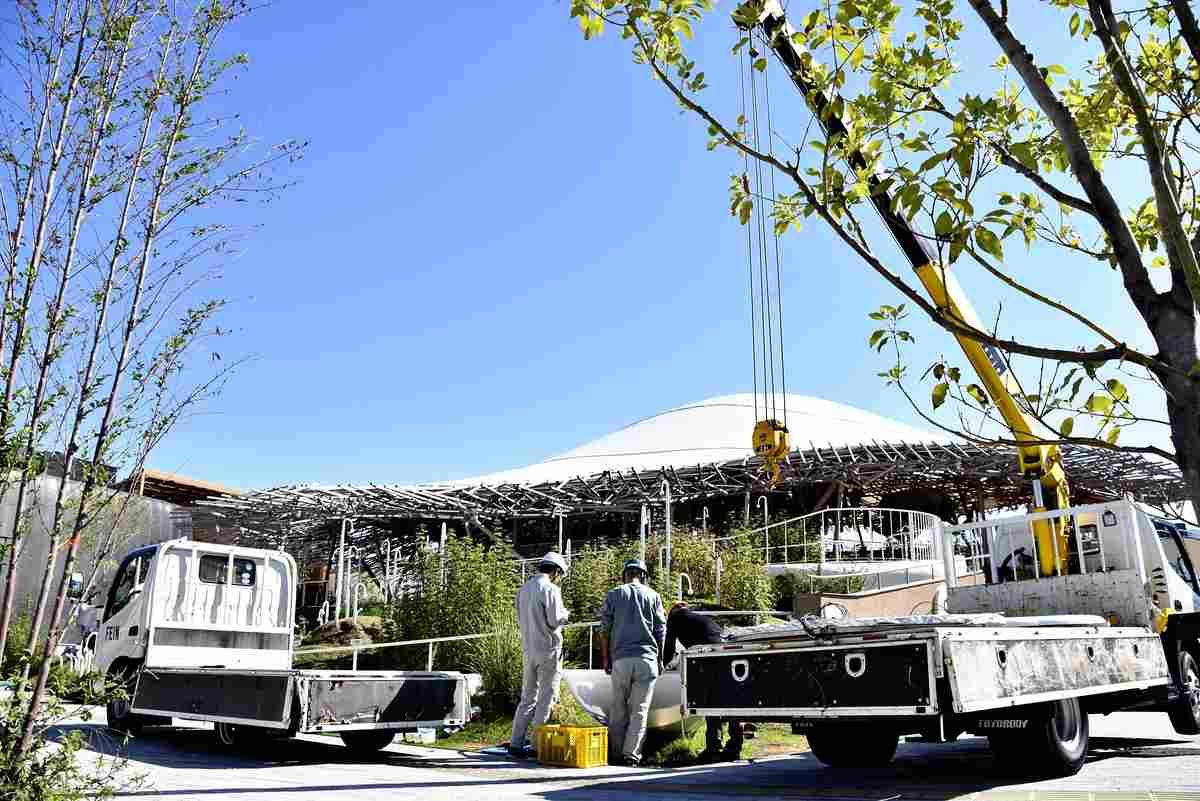
The Yomiuri Shimbun
The removal of planting and other fixtures is underway at the Osaka-Kansai Expo venue in Konohana Ward, Osaka, on Oct. 23.
14:40 JST, October 31, 2025
OSAKA — Although dismantling work has started at the site of the 2025 Osaka-Kansai Expo, which closed on Oct. 13, how the pavilions’ materials will be reused after they are demolished remains a significant challenge.
The 84 pavilions, which hosted huge crowds of visitors, will be disposed of if locations for reuse are not found. A crucial post-Expo task is determining whether this Expo, which championed environmental consideration, can successfully reuse its buildings and materials.
On Oct. 23, trucks came and went along the Grand Ring, the Expo’s symbolic structure, on Yumeshima, an artificial island in Osaka. Workers were seen carrying exhibits out of the pavilions and scaffolding for demolition work had been set up in front of the Bulgaria Pavilion.
The participating countries and companies that constructed the pavilions, along with the Japan Association for the 2025 World Exposition, are in charge of demolition. They are also individually responsible for finding reuse locations.
Yoichi Ochiai, a media artist who produced the null² pavilion, said on Oct. 3 that he intends to relocate part of it to outside the Kansai region. The pavilion drew attention with an exhibit that allowed dialogue with a 3D alter ego.
“I will bring what the residents of the Kansai region were enthusiastic about to the rest of Japan,” Ochiai said. Although the location is still undecided, “I want to build it in such a way that people will clearly remember that it was here at the Expo.”
Against a backdrop of increased environmental awareness, many pavilions at the Expo were specifically designed for future reuse, such as the Women’s Pavilion. The steel pipes and membrane material covering its exterior will be moved to the International Horticultural Expo 2027, which is set to begin in Yokohama in March 2027. The materials had already been used in the Japan Pavilion at the 2020 Dubai Expo.
“I hope to popularize the concept of making something new from what is already available,” said architect Yuko Nagayama, who designed the pavilion.
The Expo Association’s Green Vision environmental policy, announced in March, explicitly set a goal of achieving the reuse of more than 17.5 pavilions. This figure was calculated by assigning a value of one for full relocation and 0.5 for cases involving the partial reuse of materials.
The Grand Ring, the world’s largest wooden structure, has a circumference of about 2 kilometers. Two hundred meters of it will be preserved on site, and the rest will be dismantled. The wood is set to be used for various purposes, including the construction of housing for people affected by the 2024 Noto Peninsula Earthquake.
The Yomiuri Shimbun has learned that only 11 of the 84 pavilions have concrete reuse plans. This includes the Netherlands Pavilion, which is to be entirely relocated to Awaji Island in Hyogo Prefecture. The China Pavilion has announced plans to reuse its pavilion, but the details have yet to be finalized.
High costs are one of the hurdles of reusing pavilions. The buildings for the six-month-long Expo are classified as temporary structures, so the cost of redesigning them to meet building codes outside the site and transporting them to a reuse location often exceeds disposal costs.
Ochiai is seeking donations through crowdfunding with a goal of ¥300 million, citing a lack of funds for redesign and other costs associated with the relocation of null².
Race against time
If the pavilions are not reused, their structural material, interior finishes and exterior wall materials will be thrown away.
Based on data from past Expos, the association estimates that a total of 760,000 tons of waste will be generated. Although the association plans to recycle 98% of this waste, limiting final disposal to 14,000 tons, the remaining amount is still equivalent to about the capacity of 2,150 large trucks.
Themed and joint pavilions built by the association must be dismantled, the land must be leveled and the land must be returned to the Osaka city government by the end of February 2028. Meanwhile, the 42 pavilions built by participating countries have to be dismantled by April 13, 2026, less than six months from now.
Issues of unpaid construction costs occurred with some pavilions during the construction phase, and there are concerns that demolition work may be delayed if troubles also arise during dismantling.
“Careful dismantling is necessary for reuse, which takes more time than disposal. Calculating backward from that, the decision on reuse should [have been] finalized around October at the latest,” said an official from the association.


AloJapan.com